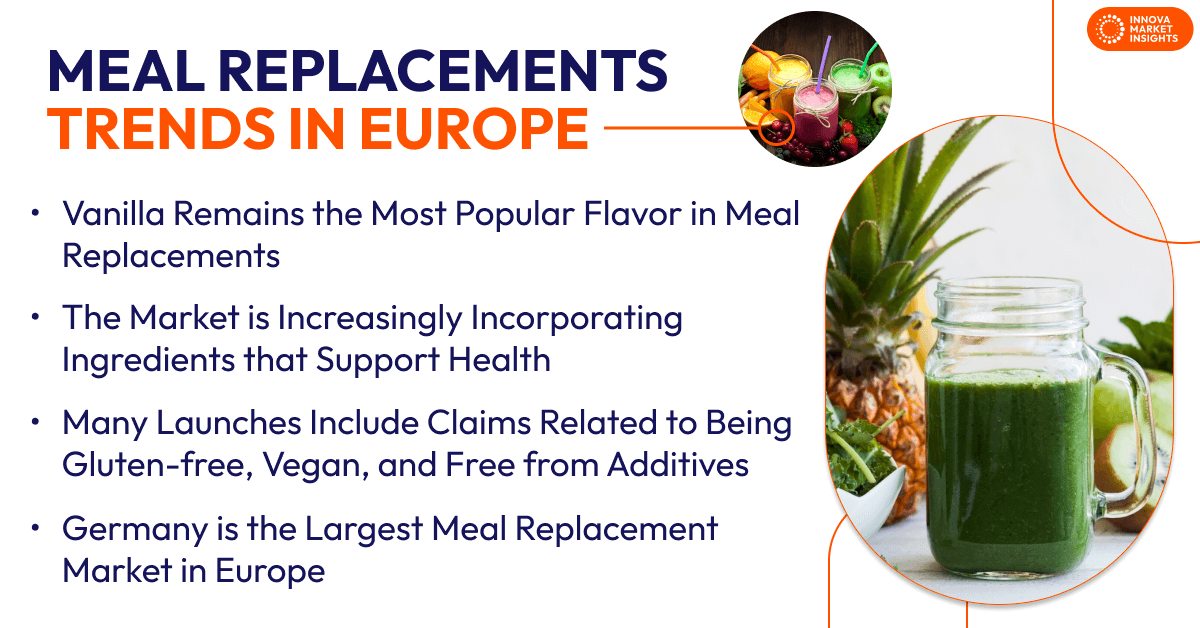February 25, 2025 – The European meal replacements market is undergoing a transformation, driven by a growing emphasis on health and wellness. Consumers are increasingly seeking out products that offer nutritional benefits, convenience, and indulgence, leading to a dynamic landscape of innovation. Innova’s 360 research highlights the key trends shaping the category, highlighting the flavors, ingredients, and positioning strategies that are gaining traction
Europe Flavor Trends in Meal Replacements
Vanilla remains the most popular flavor among consumers of meal replacements in Europe, with 20% choosing this option. However, flavors like blueberry and cocoa are gaining popularity. Additionally, 47% of consumers indicate a preference for familiar flavors, which is reflected in the ongoing appeal of classic choices such as berries, pear, and green apple.
While health remains a top priority for consumers, there is an increasing demand for indulgent experiences. This meal replacements trend, referred to as “indulging health,” highlights the rising popularity of flavorful meal replacements and drinks that successfully combine taste with nutrition.
Manufacturers are responding by innovating and creating products with delicious flavors, including chocolate, berries, macchiato coffee, and pistachio, catering to consumers who seek a balance between healthy options and satisfying tastes. Texture is also an important consideration for many consumers, with a preference for smooth and creamy consistencies.
Trending Ingredients in Europe
Brands are incorporating ingredients known for their blood lipid regulation, muscle preservation, and gut health benefits, catering to consumers’ proactive approach to wellness.
Sugar reduction is a prevalent concern for European consumers, with “no added sugar” ranking as one of the top five positioning claims. This meal replacements trend is driving the development of products featuring non-nutritive sweeteners such as stevia.
High protein claims dominate the category, driven by consumers’ desire for products that support weight management, muscle preservation, and satiety. Manufacturers are incorporating a wide range of protein sources, including milk-derived protein, legumes, and cereals. Fiber is another key ingredient gaining prominence, with consumers increasingly prioritizing gut health. Prebiotics and other fibers are being incorporated to provide bulk and support digestive well-being.
Plant-based ingredients continue to be a major trend in the category of meal replacements in Europe, while products that are free from certain ingredients, such as gluten, dairy, and sugar, are also becoming increasingly popular.

Positioning and Claims in Meal Replacements in Europe
Within the meal replacements category in Europe, the majority of launches feature claims related to health, convenience, and ethical considerations. Products are positioned as quick options to substitute regular meals, catering to individuals actively seeking time-efficient solutions for their dietary needs.
Meal replacements and drinks are marketed as a means to improve physical health, often emphasizing low/no fat and sugar formulations, alongside balanced nutrient profiles. A significant portion of launches have gluten-free, vegan, and plant-based claims, reflecting consumer demand for products aligned with their values and needs.
85% of launches in the meal replacements industry include claims regarding additives and preservatives, highlighting the importance of transparency and natural ingredients to consumers. 60% of launches feature lactose-free claims, reflecting the growing demand for dairy-free alternatives. A significant portion of launches also feature weight management claims, demonstrating the rising prevalence of obesity and the demand for products that support healthy weight goals.
Leading Meal Replacement Markets in Europe
Germany leads the meal replacement market in Europe. Germany has seen significant growth in weight management claims, with manufacturers incorporating ingredients such as fiber, resistant starch, and plant protein to support muscle preservation and satiety. This proactive approach to health and wellness aligns with the growing focus on preventing potential health issues and promoting a balanced lifestyle.
Spain is the fastest-growing meal replacements market in Europe, showing a 38% increase in launches. This growth can be attributed to a strong emphasis on weight management, as consumers in Spain increasingly seek options to achieve personal well-being. Additionally, the use of natural and non-nutritive sweeteners like stevia is gaining traction, catering to the rising demand for sugar reduction in food products. This trend is reflected in the increased presence of sugar reduction claims in meal replacement launches.
While the United Kingdom, Sweden, and Denmark also contribute to the meal replacement market in terms of new product launches, their market shares are lower than those of Germany and Spain. Despite the lower market share, these countries still showcase a significant interest in meal replacement products, particularly those that promote weight management and prioritize healthy ingredients, aligning with the overall European trend towards healthier food choices.
What’s Next in Meal Replacements Market Trends in Europe?
The meal replacement market in Europe is set for continued growth, driven by several factors. These include an increasing focus on health and wellness, a shift towards convenient and nutritious options, and a heightened awareness of proactive health management. Consumers are actively seeking products that help them maintain a balanced diet, manage their weight, and support their overall well-being. This trend is reflected in the growing emphasis on weight management claims, fiber content, and ingredients that promote gut health, such as prebiotics, driving innovation in the meal replacements industry.
Looking ahead, we expect a stronger focus on customization and personalization in the meal replacement sector. Consumers are increasingly interested in products tailored to their individual needs and preferences, taking into account specific dietary requirements, flavor profiles, and nutritional goals. This may lead to a broader range of meal replacement formats, including ready-to-drink options, customizable powders, and functional ingredients designed to address specific health concerns.
Additionally, there is a rising demand for plant-based and vegan meal replacements, reflecting a growing consciousness of sustainability and ethical consumption.
This article is based on Innova’s Overview in Meal Replacements & Other Drinks in Europe report. This report is available to purchase or with an Innova Reports subscription. Reach out to find out more